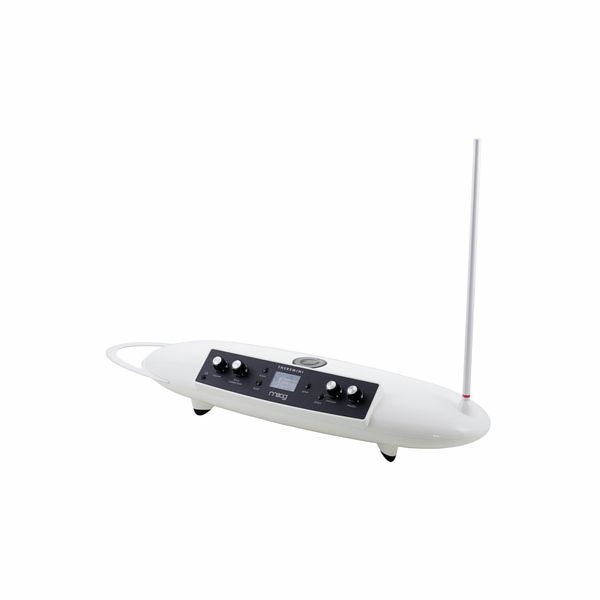Moog Theremini B-Stock
Theremin
- Variable quantization
- Integrated tuner
- 32 Memories for performance parameters such as basic tone and scaling
- Integrated speaker
- Adjustable stereo Ping-Pong Delay
- Headphone output
- MIDI USB Connection
- CV output
- 2x Line outputs 6.3 mm jack
- 3/8" Thread for mounting on a tripod
- LCD
- Dimensions (W x H x D): 578 x 381 x 165 mm
- Weight: 1.3 kg
A fresh new take on the theremin
The theremin has a long and illustrious history in popular music, and Moog has now reimagined this classic instrument in a compact new version: The Theremini. Company founder Bob Moog owed his initial success and the reputation that came with it to these instruments, which guaranteed musical success regardless of age or physical ability. Both the original incarnation of the instrument developed in the 1920s and its later interpretations are controlled via two antennae, though the sound synthesis is now carried out by Moog's Anisotropic sound engine which, the manufacturer states, captures the sonic vocabulary of Moog's synthesizers and allows it to be intuitively controlled via tablet computer, thus combining the touch-free experience of an authentic theremin with cutting-edge sound technology. Users who have an iPad can also shape and customise the sound using the in-depth parameterisation options provided by the free Theremini app.

:format(jpeg))
Antennae for volume and pitch
The Moog Theremini has a horizontal loop antenna used to control the volume and a vertical rod antenna used to control the pitch, and the control interface comprises four rotary controls for volume, pitch correction, effect level, and presets, the latter of which are also displayed together with the selected scale and the selected effect via the LC screen. To help the player improve their pitch accuracy while playing, the note being played is displayed on the left side of the screen, while the horizontal bar and diamond on the right show the accuracy of the note. The "Scale" and "Root" buttons to the left of the display allow the player to select the key in which they wish to play: Pressing the respective button scrolls through the individual settings, while holding it and rotating the Preset knob allows the selection to be made more quickly. The Theremini also features a built-in stereo delay effect with a selection of three settings (short, medium, and long) which can be set using the Effect button, and the player can adjust the effect level using the Amount knob.
:format(jpeg))
A theremin for all occasions
The Theremini is for everybody who wants to liven things up by integrating an experimental instrument into their performance. It can be played in any situation thanks to its integrated speaker and even silently thanks to the headphone output located on the control panel. What is more, a 3/8" threaded mount is included on the bottom of the Theremini to allow it to be mounted on a stand (available separately) and played standing up - perfect for live performances. The rear panel of the Theremini features a stereo output for which the output level can be determined via the Master Volume section of the settings menu, as well as a control voltage (CV) output for controlling external hardware devices. The function and voltage range of the CV output can be switched between 0V and 5V or 0V and 10V in the MIDI/CV Setup menu. And to ensure that the Theremini will still be there when you get back, the rear panel also features a Kensington MiniSaver cable lock slot for enhanced security.
:format(jpeg))
About Moog
The US manufacturer of synthesizers, based in Asheville, North Carolina, is one of the pioneers in this field and has legendary status. Robert Moog had been involved with electronic sound generation since the 1950s and his first experience was with the manufacture of theremins. The breakthrough came in 1968 with the Grammy-winning album "Switched-On Bach" by musician Wendy Carlos (then know as Walter Carlos), recorded in multitrack with a mono synthesizer. The Minimoog, released in 1971, became the most popular synthesizer of the 1970s and is still considered the benchmark for the quality of synthesised sounds. It and the following devices, like the Memorymoog, Polymoog, and Prodigy, shaped the sound of numerous albums, from Stevie Wonder to The Police and from Saga to Kraftwerk.
Calibration made easy
The Theremini needs to be calibrated in order to adapt to its environment and to the player's body movements and playing style, and the calibration process should be repeated whenever it is set up in a new location or has been unused for an extended period of time. The dedicated menu guides the user step-by-step throught the hand movements required to make the necessary settings. When the Auto Mute function is deactivated, the Theremini will continue to drone at the lowest selected note when the hand that controls the pitch antenna is out of range; when this function is activated, it will instead stop playing or mute itself. As well as a detailed and illustrated guide to the calibration procedure, the included instruction manual also provides useful tips regarding playing technique and handling. The Presets knob is incremented and as mentioned above can be used to scroll through 32 different presets and find the desired sound quickly and easily as well as to set various parameters in the menus via the LC display. The USB-B port can also be used to send and receive MIDI data, allowing external hardware to be controlled or MIDI data to be recorded to a DAW.









